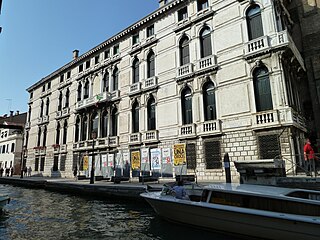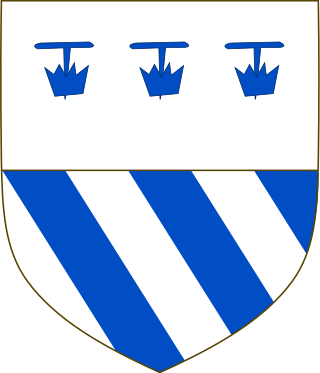
The Doge's Palace is a palace built in Venetian Gothic style, and one of the main landmarks of the city of Venice in northern Italy. The palace was the residence of the Doge of Venice, the supreme authority of the former Republic of Venice. It was built in 1340 and extended and modified in the following centuries. It became a museum in 1923 and is one of the 11 museums run by the Fondazione Musei Civici di Venezia.

The Patriarchal Cathedral Basilica of Saint Mark, commonly known as St Mark's Basilica, is the cathedral church of the Patriarchate of Venice; it became the episcopal seat of the Patriarch of Venice in 1807, replacing the earlier cathedral of San Pietro di Castello. It is dedicated to and holds the relics of Saint Mark the Evangelist, the patron saint of the city.

Cannaregio is the northernmost of the six historic sestieri (districts) of Venice. It is the second largest sestiere by land area and the largest by population, with 13,169 people as of 2007.

The Grand Canal is a channel in Venice, Italy. It forms one of the major water-traffic corridors in the city.

Comacchio is a town and comune of Emilia Romagna, Italy, in the province of Ferrara, 48 kilometres (30 mi) from the provincial capital Ferrara. It was founded about two thousand years ago; across its history it was first governed by the Exarchate of Ravenna, then by the Duchy of Ferrara, and eventually returned to be part of the territories of the Papal States. For its landscape and its history, it is considered one of the major centres of the Po delta.

Giovanni Tiepolo was Patriarch of Venice from 1619 to his death.

Actv S.p.A. is a public company responsible for public transportation in Venice and Chioggia municipalities and for interurban bus services in province of Venice. ACTV is not responsible for Venice People Mover and waterbus routes between airport and the lagoon area. Connections by bus with Venice airport are managed by ACTV and by ATVO.

Venezia Santa Lucia is the central station of Venice in the north-east of Italy. It is a terminus and located at the northern edge of Venice's historic city . The station is one of Venice's two most important railway stations; the other one is Venezia Mestre, a mainline junction station on Venice's mainland district of Mestre. Both Santa-Lucia and Mestre stations are managed by Grandi Stazioni and they are connected to each other by Ponte della Libertà.

The Venice Marathon is a marathon road race that has been held each year in Venice since 1986, usually in October. The course starts in Stra and passes through Mestre, Parco San Giuliano, and Ponte della Libertà before ending at Riva dei Sette Martiri in Venice. The marathon is categorized as a Bronze Label Road Race by World Athletics.

Ca' Farsetti is a palace in Venice, Italy. It is located in the sestiere (district) of San Marco, and faces the Grand Canal, not far from the Ponte di Rialto. The neighboring building is Palazzo Cavalli.

Corso Vittorio Emanuele II, commonly known as Corso Vittorio, is a wide east–west thoroughfare that courses through Rome. It connects a bridge over the Tiber, Ponte Vittorio Emanuele II, to both the Via Torre Argentina and Via del Plebiscito. The latter Via continues east from Piazza del Gesù and along Palazzo Venezia to reach Piazza Venezia which sits below the massive white Monument to Vittorio Emanuele II.

The Palazzo da Lezze or Ca' Lezze is a Baroque palace in Sestiere of Cannaregio in the city of Venice, Italy. It is located on Rio della Misericordia, with a facade on the fondamenta (canal-sidewalk), and stands between the Scuola Grande Nuova della Misericordia and Calle Largo Lezze.

The Riva degli Schiavoni is a monumental waterfront in Venice. It is located in the sestiere of Castello and extends along the San Marco basin in the stretch from the Ponte della Paglia bridge, close to the Doge's Palace to the rio di Ca' di Dio.

The Palazzo Bernardo a San Polo, also known as the Giustinian Bernardo is a Gothic-style palace located between Palazzo Querini Dubois and across the Rio del la Madoneta, Casa Sicher, on the Grand Canal in the sestiere of San Polo of Venice, Italy.

Emmanuele Antonio Cicogna was an Italian writer, scholar, and book collector. He left his huge collection of books to the city of Venice and it now forms part of the Museo Correr.

The Moro family was a patrician family of the Republic of Venice.

Palazzo Moro Lin, also known as Palazzo Morolin Michiel Olivo, is a Venetian palace located in the San Polo sestiere.




















